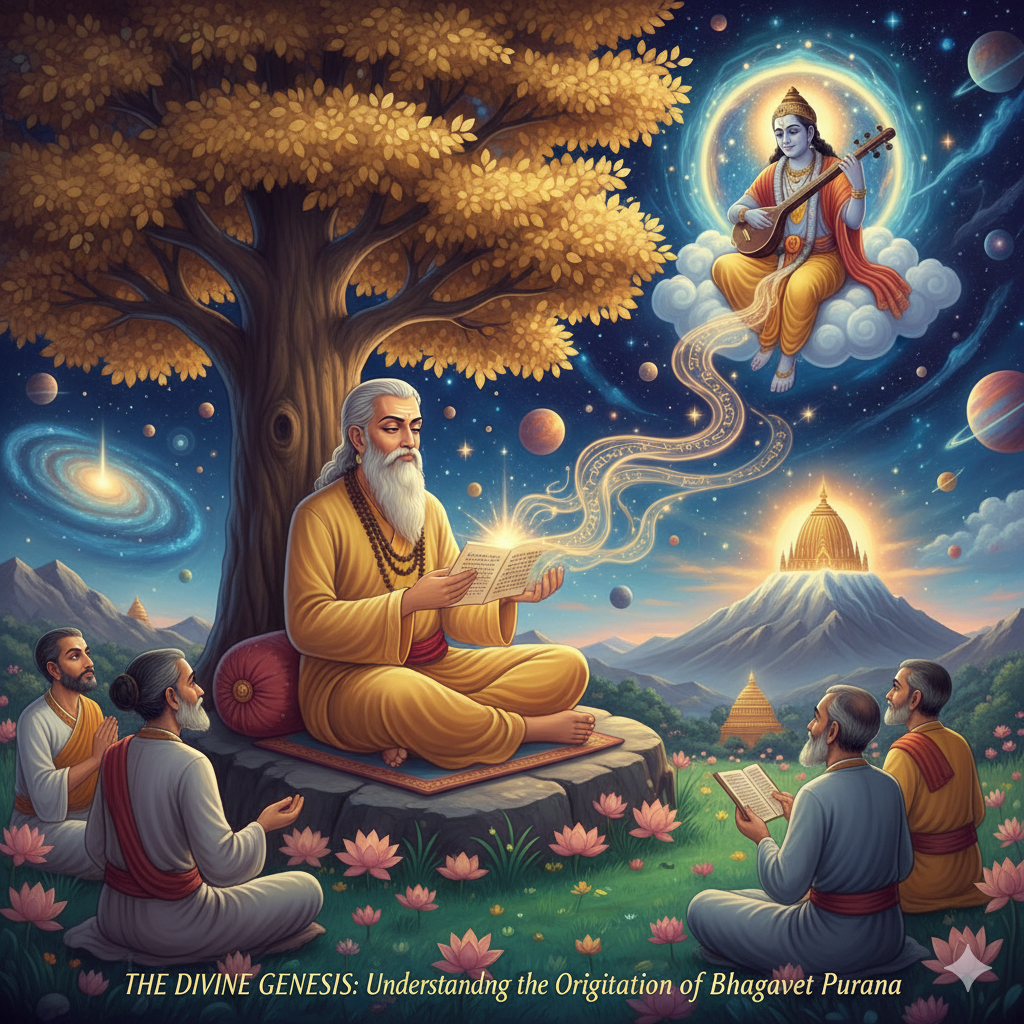The Srimad Bhagavat Purana, also known as the Bhagavatam, stands as one of the most revered texts in Hindu literature, representing the pinnacle of devotional wisdom and spiritual knowledge. Understanding its origination reveals not just historical context, but the divine purpose behind this sacred scripture that has guided countless souls toward spiritual enlightenment for millennia.
The Divine Author: Sage Vyasa
The origination of Bhagavat is attributed to Sage Vedavyasa, the legendary compiler of the Vedas and author of the Mahabharata. According to traditional accounts, Vyasa composed this magnificent work over 5,000 years ago, at the transition from Dvapara Yuga to Kali Yuga. Vyasa, whose name literally means “editor” or “compiler,” undertook this monumental task to preserve divine wisdom for future generations who would lack the memory to retain oral traditions.
The Spiritual Catalyst: Narada’s Guidance
The creation of the Bhagavat Purana has a profound spiritual backstory. After completing the Vedas, Puranas, and the Mahabharata, Sage Vyasa experienced spiritual dissatisfaction despite his vast literary accomplishments. It was then that Sage Narada appeared to him with divine guidance, explaining that his previous works had not sufficiently emphasized pure devotional service to Lord Krishna.
Narada counseled Vyasa to compose a text that would exclusively glorify Krishna and focus on bhakti (devotional service). This divine intervention led to the creation of what we know today as the Srimad Bhagavatam—a work specifically designed to awaken devotion in the hearts of readers.
The Composition Process: Two Versions
The origination of Bhagavat involved a unique two-stage composition process. Initially, Vyasa wrote the Bhagavat as one of the eighteen Puranas. However, following Narada’s instruction, he edited and expanded this work, creating what scholars describe as the “amala purana” (spotless Purana). This revised version became the Srimad Bhagavatam we study today, with its exclusive focus on Krishna’s divine pastimes and pure devotional principles.
Historical Perspectives on Dating
While traditional sources place the Bhagavat Purana’s composition 5,000 years ago, modern scholarship offers different perspectives. Academic researchers generally date its composition between 500-1000 CE, with most scholars favoring the 9th-10th century CE. However, some evidence suggests possible earlier origins, with certain portions potentially dating back to the 4th-6th centuries.
The text’s sophisticated spiritual philosophy, emotional bhakti expression, and linguistic style have led scholars to trace its origins to South India, particularly the Tamil region, where it may have been influenced by the Alvar saints’ devotional poetry.
The Divine Transmission
The origination of Bhagavat extends beyond mere composition to its divine transmission. According to tradition, Vyasa first taught this sacred text to his liberated son, Sukadeva Goswami. Sukadeva then narrated it to King Parikshit on the banks of the Ganges, creating the framework within which the entire Bhagavatam is presented.
This transmission represents more than historical succession—it embodies the guru-disciple tradition essential to understanding spiritual knowledge. The Bhagavatam itself emerged from Vyasa’s samadhi consciousness, earning it the designation “Samadhi Bhasha” (the language of spiritual absorption).
The Eternal Relevance
The origination of Bhagavat serves a timeless purpose: to provide spiritual guidance for souls trapped in material existence. Vyasa composed this work specifically for the age of Kali, when spiritual practices would become difficult and people would have shorter lifespans and weaker memories. The Bhagavatam offers a direct path to Krishna consciousness through hearing and chanting His glories.
FAQ
Q: Who originally composed the Bhagavat Purana?
A: The Bhagavat Purana was composed by Sage Vedavyasa (Vyasa Muni), the same sage who compiled the Vedas and authored the Mahabharata. Traditional accounts credit him with its composition over 5,000 years ago.
Q: Why did Vyasa write the Bhagavat Purana?
A: Vyasa wrote the Bhagavatam after feeling spiritually dissatisfied despite completing numerous other scriptures. Sage Narada guided him to compose a work that would exclusively focus on devotional service to Lord Krishna and awaken pure bhakti in readers’ hearts.
Q: What makes the Bhagavat Purana unique among other Puranas?
A: The Bhagavat Purana is called the “amala purana” (spotless Purana) because it exclusively focuses on Krishna’s divine pastimes and pure devotional service. Unlike other Puranas that cover various topics, the Bhagavatam maintains singular focus on bhakti and spiritual liberation.

